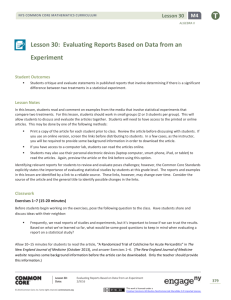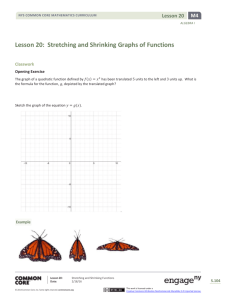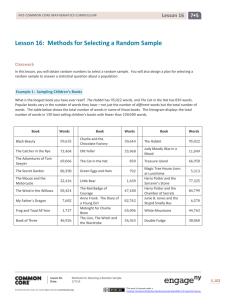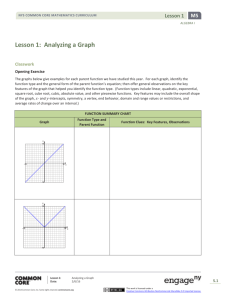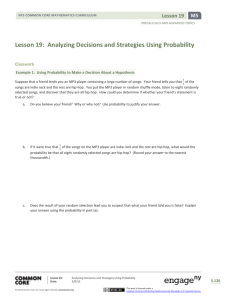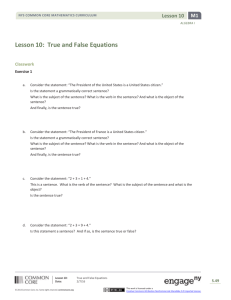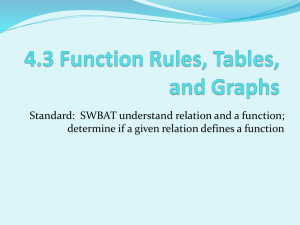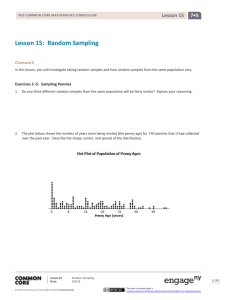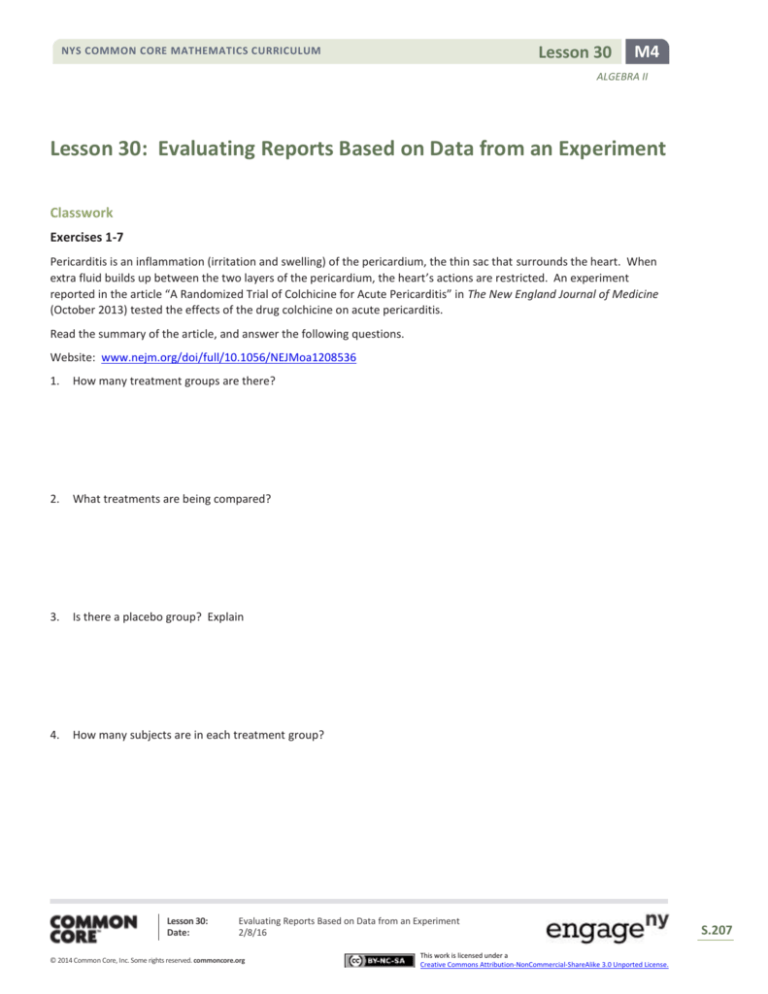
Lesson 30
NYS COMMON CORE MATHEMATICS CURRICULUM
M4
ALGEBRA II
Lesson 30: Evaluating Reports Based on Data from an Experiment
Classwork
Exercises 1-7
Pericarditis is an inflammation (irritation and swelling) of the pericardium, the thin sac that surrounds the heart. When
extra fluid builds up between the two layers of the pericardium, the heart’s actions are restricted. An experiment
reported in the article “A Randomized Trial of Colchicine for Acute Pericarditis” in The New England Journal of Medicine
(October 2013) tested the effects of the drug colchicine on acute pericarditis.
Read the summary of the article, and answer the following questions.
Website: www.nejm.org/doi/full/10.1056/NEJMoa1208536
1.
How many treatment groups are there?
2.
What treatments are being compared?
3.
Is there a placebo group? Explain
4.
How many subjects are in each treatment group?
Lesson 30:
Date:
Evaluating Reports Based on Data from an Experiment
2/8/16
© 2014 Common Core, Inc. Some rights reserved. commoncore.org
This work is licensed under a
Creative Commons Attribution-NonCommercial-ShareAlike 3.0 Unported License.
S.207
Lesson 30
NYS COMMON CORE MATHEMATICS CURRICULUM
M4
ALGEBRA II
5.
Do you think that the number of subjects in each treatment is enough? Explain.
6.
What method was used to assign the subjects to the treatment groups? Explain why this is important.
Suppose newspaper reporters brainstormed some headlines for an article on this experiment. These are their suggested
headlines:
A. “New Treatment Helps Pericarditis Patients”
7.
B.
“Colchicine Tends to Improve Treatment for Pericarditis”
C.
“Pericarditis Patients May Get Help”
Which of the headlines above would be best to use for the article? Explain why.
Exercises 8-10
What you should look for when evaluating an experiment . . .
Were the subjects randomly assigned to treatment groups?
Was there a control group or a comparison group?
Were the sample sizes reasonable large?
Do the results show a cause and effect relationship?
Read the summary of the two articles below. Write a few sentences evaluating these articles using the guidelines above.
8.
The study “Semantic Memory Functional MRI and Cognitive Function after Exercise Intervention in Mild Cognitive
Impairment” (Journal of Alzheimer’s Disease, November 2013) was performed to see if exercise would increase
memory retrieval in older adults with mild cognitive impairment (associated with early memory loss).
Website: http://iospress.metapress.com/content/xm8t241628h37h7t/
Lesson 30:
Date:
Evaluating Reports Based on Data from an Experiment
2/8/16
© 2014 Common Core, Inc. Some rights reserved. commoncore.org
This work is licensed under a
Creative Commons Attribution-NonCommercial-ShareAlike 3.0 Unported License.
S.208
Lesson 30
NYS COMMON CORE MATHEMATICS CURRICULUM
M4
ALGEBRA II
9.
The article “Effects of Bracing in Adolescents with Idiopathic Scoliosis” (New England Journal of Medicine, October
2013) reports on the role of bracing patients with adolescent idiopathic scoliosis (curvature of the spine) for
prevention of back surgery.
Website: www.nejm.org/doi/full/10.1056/NEJMoa1307337
10. View the report by Tom Bemis (Market Watch, Wall Street Journal, August 13, 2013) about the type of car driven by
a person and the person’s driving behavior.
Website: http://live.wsj.com/video/bmw-drivers-really-are-jerks-studies-find/29285015-BB1A-4E41-B0C00A41CB990F60.html#!29285015-BB1A-4E41-B0C0-0A41CB990F60
Is the title “BMW Drivers Really Are Jerks” an accurate title for these reported studies? Why or why not? If not,
suggest a better title.
Lesson 30:
Date:
Evaluating Reports Based on Data from an Experiment
2/8/16
© 2014 Common Core, Inc. Some rights reserved. commoncore.org
This work is licensed under a
Creative Commons Attribution-NonCommercial-ShareAlike 3.0 Unported License.
S.209
Lesson 30
NYS COMMON CORE MATHEMATICS CURRICULUM
M4
ALGEBRA II
Lesson Summary
A cause and effect relationship can only be shown by a well-designed experiment.
Randomly assigning the subjects to treatment groups evens out the effects of extraneous variables to
create comparable treatment groups.
A control group (which may be a placebo group) or a comparison group (a standard treatment) is
sometimes included in an experiment so that you can evaluate the effect of the treatment.
The number of subjects in each treatment (sample size) should be large enough for the random
assignment to experimental groups to create groups with comparable variability between the subjects.
Problem Set
Read the following articles and summaries. Write a few sentences evaluating each one using the guidelines given in the
lesson.
1.
The article “Emerging Technology” (Discover Magazine, November 2005) reports a study on the effect of
“infomania” on IQ scores.
Website: discovermagazine.com/2005/nov/emerging-technology
2.
In The New England Journal of Medicine, October 2013, the article “Increased Survival in Pancreatic Cancer With
nab-Paclitaxel Plus Gemcitabine” reports on an experiment to test which treatment, nab-paclitaxel plus gemcitabine
or gemcitabine alone, is the most effective in treating advanced pancreatic cancer.
Website: www.nejm.org/doi/full/10.1056/NEJMoa1304369
Lesson 30:
Date:
Evaluating Reports Based on Data from an Experiment
2/8/16
© 2014 Common Core, Inc. Some rights reserved. commoncore.org
This work is licensed under a
Creative Commons Attribution-NonCommercial-ShareAlike 3.0 Unported License.
S.210
Lesson 30
NYS COMMON CORE MATHEMATICS CURRICULUM
M4
ALGEBRA II
3.
Doctors conducted a randomized trial of hypothermia in infants with a gestational age of at least 𝟑𝟔 weeks who
were admitted to the hospital at or before six hours of age with either severe acidosis or perinatal complications
and resuscitation at birth and who had moderate or severe encephalopathy. The trial, “Whole-Body Hypothermia
for Neonates with Hypoxic–Ischemic Encephalopathy,” tested two treatments, standard care or whole-body cooling
for 72 hours.
Website: www.nejm.org/doi/full/10.1056/NEJMcps050929
Lesson 30:
Date:
Evaluating Reports Based on Data from an Experiment
2/8/16
© 2014 Common Core, Inc. Some rights reserved. commoncore.org
This work is licensed under a
Creative Commons Attribution-NonCommercial-ShareAlike 3.0 Unported License.
S.211

